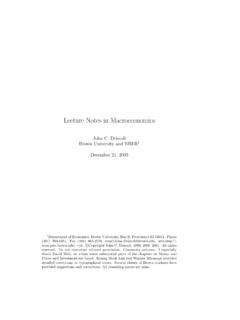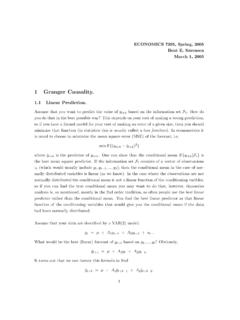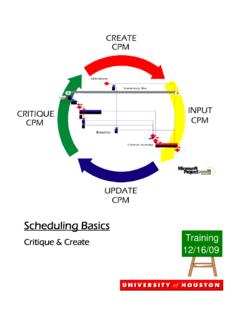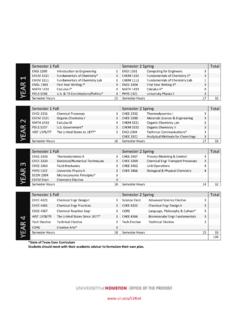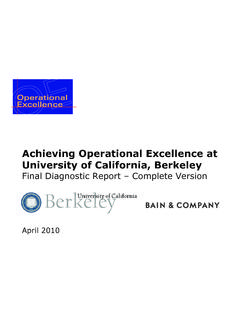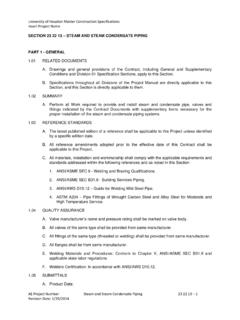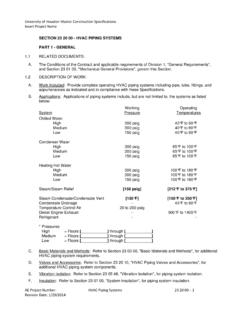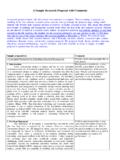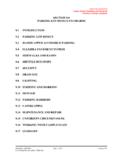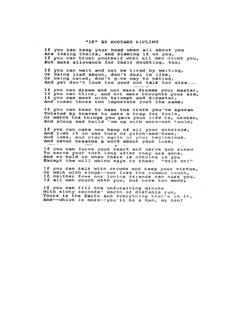Transcription of Children’s Classics Through The Lenses of Literary Theory
1 1 children s Classics Through The Lenses of Literary Theory Adam Georgandis Bellaire High School INTRODUCTION Literary Theory is largely absent from high school English courses. While virtually all high school students read and respond to literature, few are given opportunities to analyze the works they read using established, critical methods. This curriculum unit will introduce high school students to four critical approaches, and it will ask students to apply each approach to selected works of children s literature. Four methods of Literary criticism - feminism, Marxism, post-colonial criticism, and reader-centered criticism are especially useful in understanding the wide variety of texts students study in high school and college English courses.
2 Feminist criticism suggests that readers can fully comprehend works of literature only when they pay particular attention to the dynamics of gender. Many high school readers are naturally drawn to the issue of gender. In several canonical works The Scarlet Letter and The Awakening are good examples understanding the roles of key female characters is an important and provocative task. Our use of feminist criticism will produce interesting discussions of traditional gender roles and societal expectations in literature and in the world of daily experience. Marxist criticism suggests that readers must closely examine the dynamics of class as they strive to understand the works they read. Many students focus naturally on the issue of class when they read works which explicitly call attention to it the novels of John Steinbeck and Richard Wright, for example.
3 Extending this focus to works of literature which do not call particular attention to class struggle will be a challenging and potentially rewarding endeavor. Like our use of feminist criticism, our use of Marxist criticism will produce provocative discussions which seek to apply the method s ideas both to works of literature and to the world of daily experience. Post-colonial criticism is given to examining cultural changes in the many parts of the world colonized by Europeans during the last three centuries. The method s proponents study the cultures of both the colonized and the colonizers, focusing particularly on the ways in which these cultures influence (and sometimes consume) one another. In a school district defined by ethnic plurality, the lens of post-colonial criticism should be especially interesting.
4 Our use of post-colonial criticism will prompt students to examine cultural struggle as it is manifested in works of literature, in the mass media, and, in many cases, in students personal experience. 2 Reader-centered criticism dismisses the notion that works of literature contain distinct, fixed meanings. Proponents argue that new meaning is created by the transaction that takes place every time a reader engages a text. It has been my experience that high school students are easily frustrated by English teachers who deem their personal responses to literature insignificant in the face of teacher-defined correct responses. Frustrated students will find intellectual comfort in our use of reader-centered criticism.
5 With guidance, students will come to understand how a reader s personal response to a work of literature can be instrumental in making the work meaningful. To justify the addition of Literary Theory to the established English curriculum, teachers need look no further than the curriculum s stated goals, one of which is to foster critical thinking skills. The phrase critical thinking has buzzed Through teacher inservices for many years. Certainly it is useful for students to learn to think critically about their lives and about the world around them; such thinking can only lead to more informed decision-making a worthy goal, to be sure. But it often seems that, with several notable exceptions, the call to place greater emphasis on critical thinking skills is an empty call.
6 More specifically, the call to teach critical thinking skills is commonly mired in frustrating abstraction; most teachers understand what it is to think critically, but many are unsure how best to help their students reach a similar understanding. I believe that introducing methods of Literary Theory to high school English students is one way to make critical thinking a more meaningful part of their lives. Of course it is possible to use methods of Literary criticism to better understand canonical texts. But many students think of these texts as inaccessible impenetrable, even simply because they are schoolbooks, books owned by teachers and other adults. I believe that students first exposure to the methods of Literary criticism will be most successful if it is built upon the comfortable familiarity of children s Classics .
7 This curriculum unit will feature a variety of picture books, children s novels, and young adult novels. These books are engaging and accessible, even to students who did not encounter them as younger readers; they will provide the non-threatening starting place many students need as they venture into the challenging world of critical Theory . I will teach the unit in stages. Each stage will begin with my introducing a single critical method. Students will learn the ideas and practices associated with the method, then apply what they have learned in the laboratory of children s Classics . After completing each stage, students will read one or more canonical works especially suited to the method they have most recently mastered.
8 As my principal teaching assignment is Pre-AP English 2, the canonical works I choose will fit the traditional American literature track. Practice with feminist criticism might lead to Kate Chopin s The Awakening; practice with Marxist criticism might lead to John Steinbeck s The Grapes of Wrath; practice with postcolonial criticism might lead to N. Scott Momaday s House Made of Dawn; practice with reader-centered criticism might lead to Salinger s The Catcher in the Rye. Other teachers may feel free to use the unit s four stages singly or in any 3 combination, and to substitute canonical works appropriate to their specific teaching assignments. During every stage of the unit, I will remind students that each method of Literary criticism is a lens Through which they may view a wide variety of texts.
9 I will stress that what is true for the photographer is true for the critic: no lens, no critical method, is a consistent best choice. Rather, every lens, every critical method, is more useful in some situations than others. By the end of the unit s final stage, I believe my students, having worked with feminist criticism, Marxist criticism, postcolonial criticism, and reader-centered criticism, will be able to decide for themselves which critical method(s) to apply to any text they subsequently encounter. FEMINIST CRITICISM Gender can be a provocative subject for high school students. The physical and psychological confusion of adolescence, the often bitter clashes young people have with their parents, the growing desire many teenagers have to share their lives with others it is no wonder our students seize upon gender issues with a passion little known in other academic settings.
10 I believe that my students peering Through the lens of feminist criticism will make for the most engaging phase of the present unit; it is for this reason I have chosen feminist criticism as the unit s starting place. Feminist criticism is a wide-ranging field; an adequate definition of the methods of feminist criticism must include several currents of thought. The following sentence, taken from A Handbook of Critical Approaches to Literature, lists three of feminist criticism s principal tasks, Feminist critics generally agree that their goals are to expose patriarchal premises and resulting prejudices, to promote discovery and reevaluation of literature by women, and to examine social, cultural, and psychosexual contexts of literature and Literary criticism (Guerin et al.)
